Egor Volkov, Greensight: how to make a company controlled with numbers
Megamind, hello!
My current source is Egor Volkov, CEO and co-owner of the Greensight agency.

')
Greensight is known in the market for one of the brightest starts, or the bulk effect, as they call it. Having opened a week before the crisis, in a couple of years the agency turned out to be in high positions in all key ratings. In his portfolio, only first-class work and famous brands. Greensight was conceived as a subsidiary of QSOFT, and became its competitor. And they also live and work in Zelenograd and see only advantages in this.
In the management of the agency owners use a systematic approach. This means that all their business processes are controlled and strictly regulated. And Greensight is an open company and generously shares its experience and knowledge. Here you will find tips that you can implement in your business tomorrow.
If you are the head of a small and medium business, and even more so the owner of a web studio, you are experiencing a growth crisis, you do not understand how to make your employees work efficiently, you want to manage systematically, but you don’t know where to start, I strongly advise you to read this interview. Yegor and I prepared it especially for you.
- Egor, tell me, please, how did it come about that Greensight was launched as a regional production-office of QSOFT, and in fact became an independent agency?
- At that time I was in QSOFT the head of the unit (internal structural unit QSOFT). When the idea of opening a regional office arose, I suggested Zelenograd. Despite the fact that it is administratively related to Moscow, the location outside the Moscow Ring Road gave the main competitive advantage - the cost of specialists. And the presence of a large technical university solved the personnel issue.
As one of the initiators, I was assigned an organization. The new division decided to issue as a separate legal entity. I prepared a business plan, found two partners, my comrades, and hired one programmer. QSOFT handed us its current client - a major federal bank for the contract. And we set about. It was September 1st. Together with the students, we sat at the desks in our new office, which was too large for four people. And this week there was a global economic crisis. At the same time, it became clear that our client’s money would be enough only for office rent and salary.

QSOFT allowed to post on our website those projects in which I personally participated. As many think, there were no financial investments. In addition, at the beginning it was assumed that QSOFT would give us a part of their projects for succession, but very soon in the conditions of the crisis the number of orders decreased, they needed to provide their team with work. We were in free swimming. It was necessary to urgently look for new customers.
I must say that sales went fast. Already in the first month I signed two contracts for three projects - two online stores and one corporate site. Then we started working with Rolf, our key client of those years. But there was not enough money, we had very hard cash gaps. Customers did not pay. Depression. There was a time, we with partners already wanted to scatter. We met with the problems of shortage of orders and the growth of accounts receivable from the first days of our company. And hardened, probably.

By the way, the company was still not ours, we were only hired employees. In order to motivate and support us in a crisis, the guys from QSOFT gave us a little less than half of the company to share. Two years later we grew up and bought out the rest. Now we meet on all tenders as competitors. We still have friendly relations with QSOFT. Misha (Mikhail Tokovinin - from aut.) Speaks well of us. It did not work out ( Smiles ) .
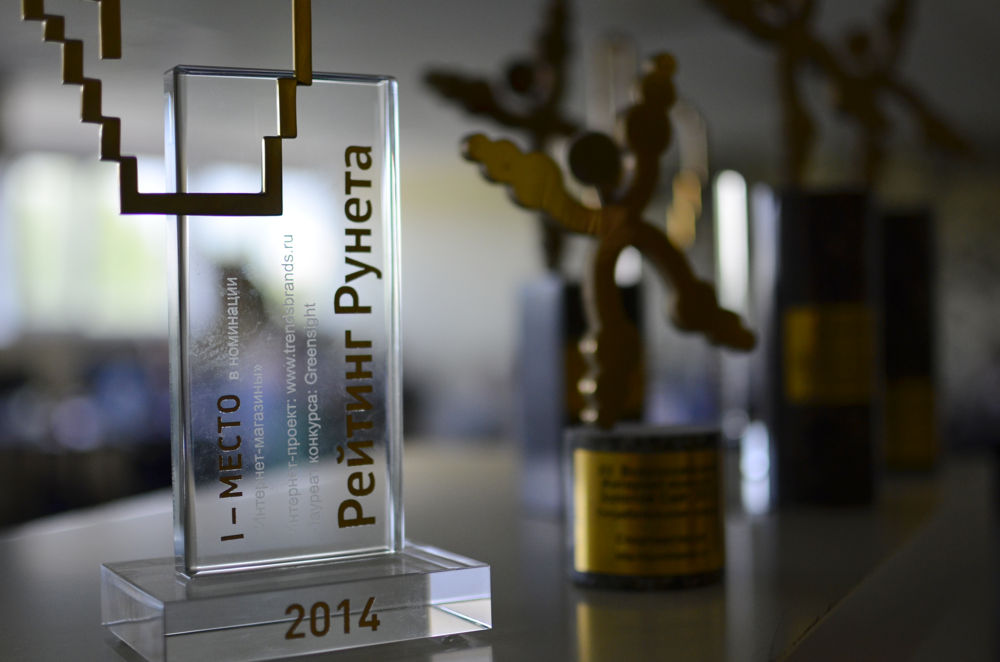
“Who else is part of Greensight’s partners besides you?”
- Pavel Sitkin, executive director, came from an integrator company. Vladimir Loskutov, our technical director, until Greensight worked in one of the oldest web studios in Zelenograd. Later we were joined by Sergey Melikhov, creative director. He was the lead designer at Deluxe Interactive, we lured him to a lower salary, but a share in the company. In Greensight, Sergei brought the design to a new level.
- So, after a year or two, you had a small team, accounts receivable, a few of your own projects in the portfolio, but you grew 1.5 - 2 times a year. How was it?
- The first time, the main channel for obtaining leads were applications from the 1C-Bitrix developers rating. In addition, we launched projects, and through word of mouth, leads led to us, which were converted into orders. We drew design on all tenders for free, even when we were not asked for it. It even seems to us that we have messed up the market with our free design. (Laughs.) We really wanted sales. By the way, now I am of the opinion that this is not necessary. By experience, we won less often than precisely in those tenders where we prepared the design.
- Tell me, what is this story with Navalny?
“Since we still did a lot of free work, Serezha Melikhov had an idea to create a social project. One day he saw a blog post from Sergei Doli, saying that some studio made him a website. The audience reach was huge! We wanted to repeat this experience. We chose 20 top bloggers and wrote them about the offer to make the site for free. And received zero responses.
Two weeks later, Alexey Navalny responded. He was not yet involved in high-profile political scandals. He liked the idea, but he could not imagine what kind of site he needed. We have prepared a detailed description of the possible options for the project, just a huge amount of text. Imagine, he answered only two months later. But we were lucky. We launched and highlighted the project simultaneously with the release of a very loud investigation of multi-billion embezzlements at Transneft and received a flurry of appeals to which we were not prepared. More than 20 applications per day. Of course, half - from fans of freebies. But there were some decent offers.
Six months later, we repeated this story and made the RosYam project for Navalny. True, this project was already paid. A new round of PR has permanently secured for us the image of a company supporting social projects. Especially in the eyes of the liberal-minded intellectuals, who were many in the top management of large companies. We hit our target audience.
- How is the organizational structure of your company? What kind of specialists does it consist of?
- All directors, accounting, office management and document management are included in the administrative department. By this we, I think, are no different from others. The development department consists of the development manager, front-end, back-end developers, web designers, system administrators. There is a sales department and a project management department consisting of project managers and the head of this direction. Our design department consists of interface designers and an art director. The latter is a hired specialist, whom we were lucky to get from another agency a year ago.
Since the direction of e-commerce is key for us, we have created an e-commerce department. This includes a marketer, web analyst and director of e-commerce, who worked in-house in top online stores. He has his own KPI system, focused on presale and postsales in his own direction.
Despite the very specific organizational structure, our activity is of a project nature. For each new project we form a separate team from different departments. Each team has a lead developer. In addition, the same person can participate in several projects simultaneously. That is, in one day an employee can work in three teams, and thanks to a very clear resource planning and separation of tasks into atomic components, his work is written up to 15 minutes.

- I noticed that in this structure you do not have an HR specialist. How do you cope without it?
- Search and selection of employees involved in the direction of the leaders. They evaluate the load, take the initiative to hire for general discussion and then select the specialists they need, full-time employees or outsourcing.
- How do sales work for you?
- All sales activities in our company are strictly regulated. The bonus system, the rules for holding meetings, negotiating, when the lead has just appeared and when negotiations are at the transaction stage, the project transfer regulations are documented and available to all employees in the internal knowledge base.
We have a big team going to meetings. I am convinced that in this case, really "alone in the field is not a warrior." First, in the company you feel more confident. Secondly, each participant has his own competences, and the negotiations are more convincing. Yes, and customers like this attention from our side. Just yesterday, we were at a meeting. And although there were only four of us, the client was very surprised, so many people had never come to them. Even the right bargaining room could not immediately be found.
We use Estonian CRM Pipedrive. This system strictly monitors the progress of the transaction. For example, a transaction must be accompanied by regular activity. If not, the system signals to the head of the sales department that his reaction is required.

Next, we collect all the transaction documentation in CRM. No matter how the communication with the client, through corporate channels or personal messengers, the information should be transferred to the project summary in CRM. What is it done for? We had problems when the sales manager was negotiating with customers on Viber or WhatsApp. And he quit before the transfer of the project, without informing the project manager of his arrangements. As a result, the client has a gap of expectations.

When the client has agreed to work together, the manager should receive information about the planned date of payment. This is a mandatory item, in the absence of which the project is not transferred to the final stage. After all, if he did not give information about payment, it means that he is not yet completely ours. On the market there is a widespread belief that a client becomes ours only when he sells a second contract. And my experience suggests that this is true.
If the client has disappeared or changed his mind, the information is also summarized. Then after a month or two a second touch occurs.
If the tender is lost, we record the reason, participants and winners in CRM. Immediately this information may not be disclosed, but later we will definitely find out about it.
The transfer of the project into production is one of the most subtle places in our work. So that the project manager does not read the entire history of communication with the client, the resume should contain detailed information about the transaction, squeeze what the sales manager agreed with the client. In addition to TK and documentation, there should be a description of the client, his psychological features, and arrangements for the future.
The transfer of the project takes place necessarily live with the sales team, the project manager and key people of the future project team. The explanation "on the fingers" means a lot.
- When did you come to the conclusion that you need CRM?
- Initially, I was one of the sales. I had a system of folders with files of requests from mail. Sometimes I forgot to save them, and turned the mail upside down in search of correspondence history. But when you're alone, you can do something on your knee. With the emergence of the sales department had to think about the competent interaction with the client.

We tried a huge number of systems, usually it did not go beyond the trial period. I can mention a few. "Megaplan" we used to manage projects and in parallel tested CRM. We did not like it. For two years I worked at Highrise 37signals. I don’t know how they are doing now, but a couple of years ago it was a terrible system, more like a notebook. We tried AmoCRM from QSOFT. It is good for most studios fit. But it is much simpler than Pipedrive, on which we ultimately settled down, and were very pleased. Attentive Russian-speaking support service, pleasant price and the richest functionality.
We try to automate processes. Mail, calendar, office applications such as Word, Excel and Powerpoint - all of this closes the infrastructure of corporate applications from Google. In business administration (hiring and firing employees, accruals, logging meetings for project groups, as well as news and events of the company, tasks outside the project processes, business processes for administration and management of the company, working groups for the development of areas, staff directory, structure companies, knowledge base and wiki regulations, etc.) - Bitrix Corporate Portal. In project management - Redmine. We are planning the loading of directions based on the LeanKit system.
- Yes, I almost forgot about project management. Are you still as strict as in sales?
- In project management, we even use two systems. The first is a resource planning system, a LeanKit electronic board, it is necessary for detailed planning of project executors loading, as well as an advance reservation of resources for up to 4 months. Every week there is a rescheduling at the so-called management summits. Project managers together with directors discuss issues related to projects, processes, conflicts in resource management.
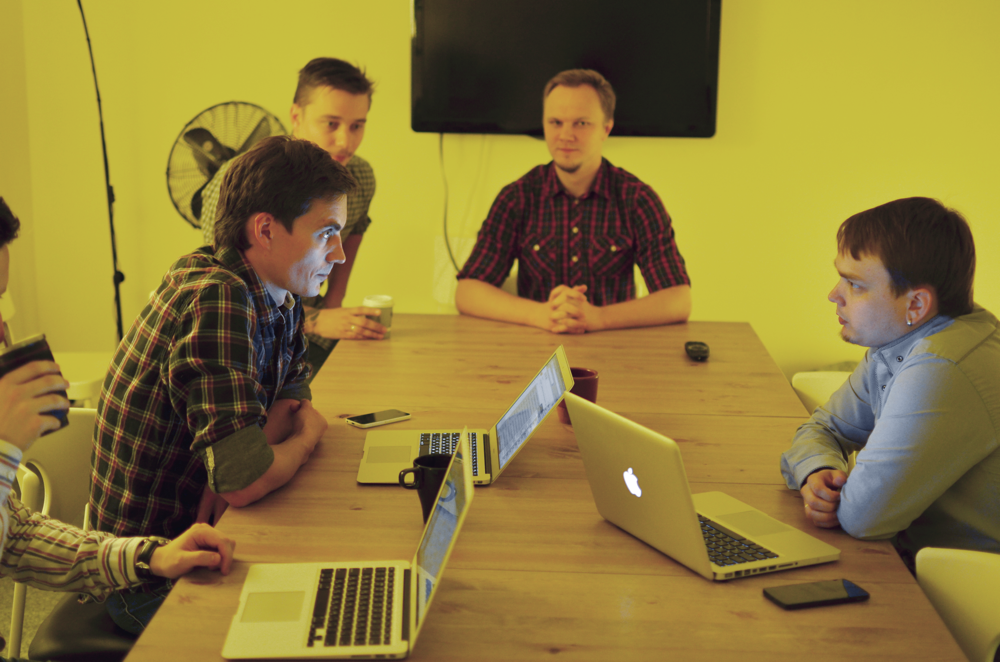
In agencies, there is a problem of lack of resources. I think it is contrived. When we introduced budgeting, it immediately became clear that freeing up resources was not so difficult. What usually happens? The sales department signals that a big project is being developed. And here the panic begins. “We need a developer and three designers at once in reserve, we won’t be able to do it,” the managers are worried. Now we all count and prioritize. We eliminate non-core, non-profitable and uninteresting projects.
Further, all the work on the project is carried out in Redmine: communication with the client and setting goals. Metrics on resource costs and cost immediately imported to our internal dashboard in Google Docs.
Our project managers and accounts are the same employees. This was done so that the manager was interested not only in completing the current project, but also in re-selling.

- You often mention in the press the so-called dashboard, which helps keep abreast of and manage the financial performance of the company. Tell me more about it.
- This is called finance dashboard. We came to this during the next development crisis in 2013. For a long time it seemed to us that everything was going well with us. But when we started counting, it turned out that intuition in business does not work, and the large revolutions of a large project are confusing. For example, when calculating the profit from a seemingly expensive project, it could turn out that it brings us losses of minus 200 thousand rubles a month. At some point we realized that we could not further develop if we did not start counting.
Our dashboard is a system of specially designed tables, it aggregates numbers across all business processes of a company. Only we (partners) see part of the data, and managers in our areas of responsibility see some.
Key indicators that we believe:
There are also data on the effectiveness of employees, for example, the top 10 managers in revenue, receivables and postsales. And many more different numbers.
By all indicators, we make a forecast, now we already have a calculation for 2016. Everything is considered automatically using Google Docs tables.
- You are not confused in such a number of numbers?
- Everyone does not need absolutely all the numbers. For this, we have divided the tables. Each manager has only the data he needs, which are exported from other tables. For example, a development manager knows about the profitability of his direction now, in the past and in the future. He sees the structure of all payments, including employee taxes. His task is to make his direction as profitable as possible, and we see only the final results.
In addition, our dashboard was introduced evolutionarily. At first we kept cash flows, then began to aggregate the data into reports, then we brought them together into a single system and began to show employees.
- Do you disclose company earnings data to employees?
- Ordinary employees do not see the pace of the company. Until. This is available only to managers. But the circle of persons is gradually expanding. We are in favor of increasing transparency with increasing our income. We have a certain level, reaching which we will be able to reveal our numbers not only to employees, but also to the market.
I believe that the Russian web development market will change as soon as the first public company appears. Then the rapid growth will begin. I think that this will happen soon enough. And we would be interested in becoming such a company. We have been working for several years already in white, we transfer wages to a card along with bonus payments and do not understand why it has become customary to argue with the crisis that business cannot survive without salaries in envelopes.
- It turns out that the disclosure of speed - is part of your motivational system?
- No, this is not motivation, but stimulation. We share these two concepts. The employee must be motivated to work initially. Material history from the field of incentives, but money cannot be a motivator. Motivation is a topic about interest, charge for work. Otherwise, you can get into a situation where you have a lot of disloyal employees motivated by the loot. In our opinion, this is wrong.

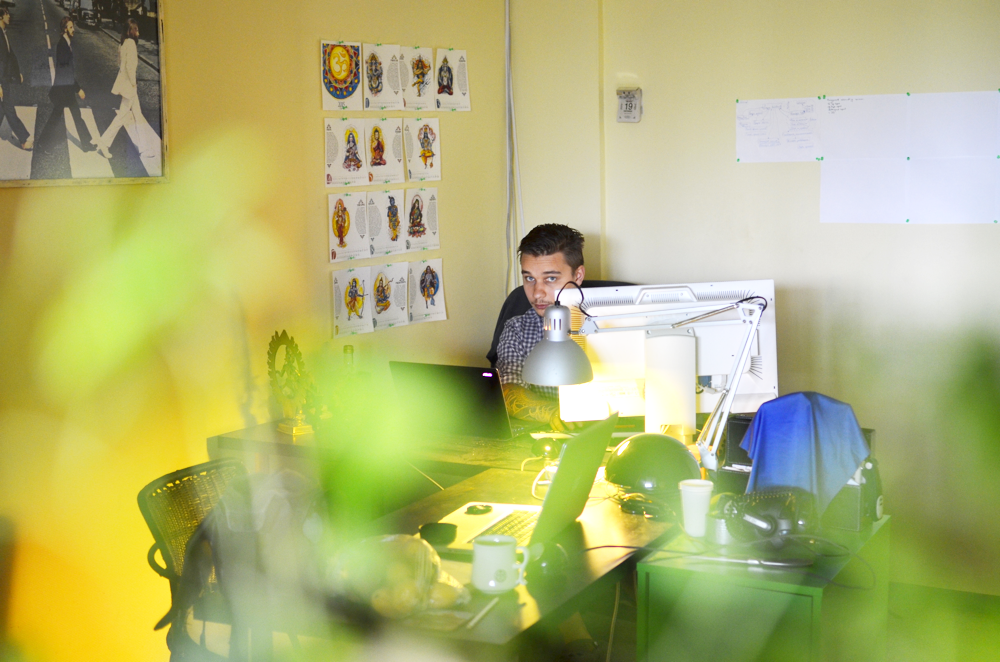
Our premium system is an incentive. And the important point is the efficiency of the project teams. According to the results of the work of production teams on projects (stages, or months of work, when it comes to SLA), the metrics from Redmine are fixed and automatically go to Google-tables, where everything is calculated and entered first in the project reporting, and then in the financial one. This allows managers to judge the performance of project teams, individual performers. In case of profitability of the project, bonuses are awarded to the project team. Premiums for SLA-projects are awarded monthly.
Within the team, the prize is distributed according to the scheme:
If someone fails, the whole team does not receive a bonus. Therefore, inefficient people are rejected by the team itself.
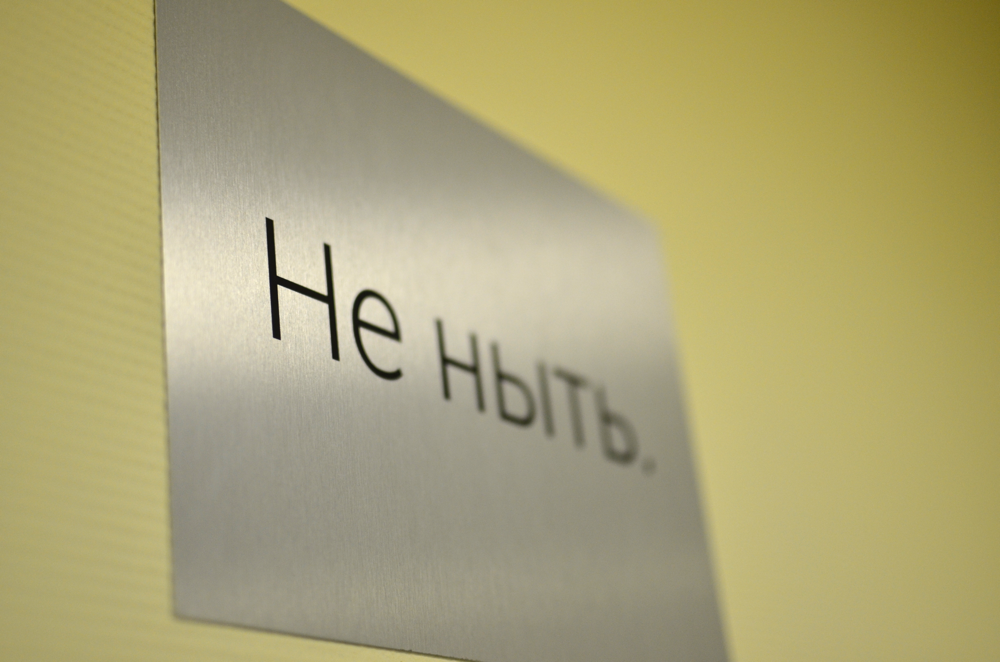
We tied the employee's stimulation to the profitability of the project implemented by him, but at the same time it was necessary to link it with the profitability of the entire business. It is not enough to deduct from the cost of the project to employees. The profitability is affected by the effectiveness of other projects, not to mention the cost of back-office, accounting, marketing.
We have been looking for the ideal formula for profitability rates for a long time and, finally, brought it ourselves.
With this formula, we were able to get rid of situations when an employee received a bonus on one project, while throwing others, and the company was at a loss (a very detailed story about material stimulation in Greensight here is from the author).
- Do you have personal recipes for winning tenders?
- They simply can not be! Tenders are an unpredictable process. Sergey Prokofiev from CreativePeople told me how they once refused to participate in the tender, and after a while they received a message that they won it. It happens.
Another situation from my practice. The client sent a proposal to participate in the tender in the top 30 studios, but put everyone in an open copy. Correspondence between the participants broke out, everyone forgot about the project and only laughed at the inept actions of the client. I decided to answer him on the merits. Wrote by removing everyone from the copy. And we won the tender. The company was from Chelyabinsk, a leading manufacturer of equipment for educational laboratories in Russia and the CIS countries. The project budget was also very good. After we talked, it turned out that the client knew that it was impossible to do this, the open copy was accidental. But he immediately became clear who is worth something.
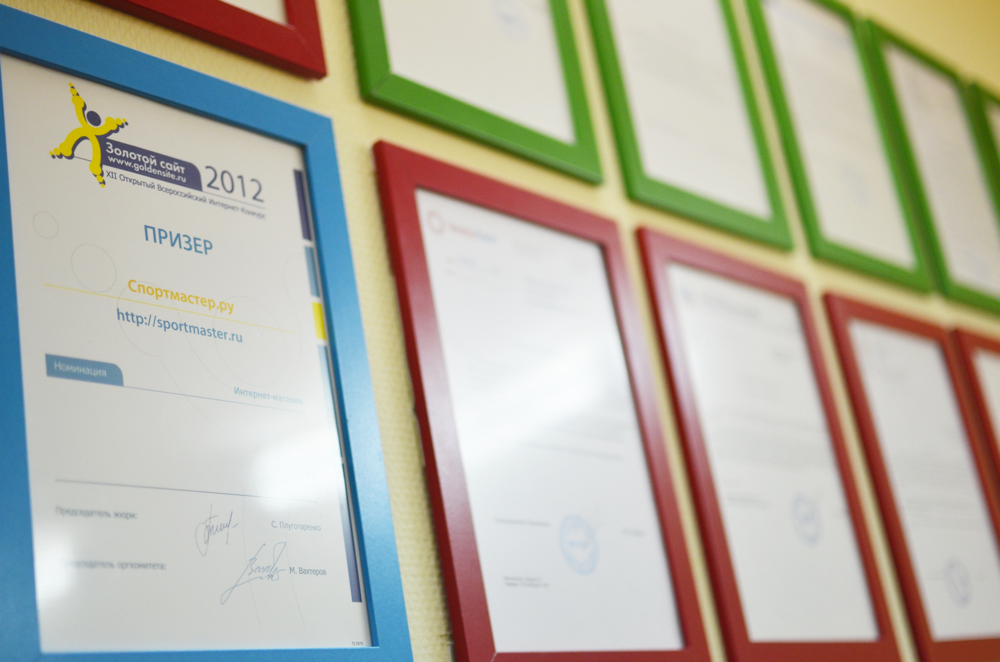
If a request is created unprofessionally, this does not mean at all that it should be filtered.
Tenders are very different. In cases when you are speaking before the board of directors of a transnational holding, your closest competitor is preparing for the door, and another one is speaking before you, the advice will not help. It comes with experience.
Definitely need a sales system and strict adherence to it. First, high-quality marketing materials: business cards, presentations, portfolio. Secondly, a clear positioning of the company, when you can immediately respond, than you are better. Thirdly, knowledge of their cases, their pros and cons, the ability to tell about themselves with interest.
If we talk about the processes, then, with other exceptions, the meeting sells best. Therefore, any more or less interesting lead needs to be converted into a meeting, and already there to hone your skills. At meetings, you can sell something that the client did not know, which he did not even think about.
And of course, the preparation for the tender plays a crucial role. We have up to seven people participating in it. The presentation for presale is a whole project work.
- On which whales, except for word of mouth, is your promotion built today?
- Big traffic bring ratings. Positions in ratings and banners. The topic of ratings is interesting. Everyone knows that they provide sales, but to get into any of them, you need a lot of quality work that can not be obtained without participating in the rating. A vicious circle of some kind. If you are not yet in the general list or you are standing somewhere at the very end, where customers do not have enough patience to penetrate, buy banners on the Tagline, Runet Rating, RUWARD. At first, these tools work the same way, because the client remembers you as a company from the rating.
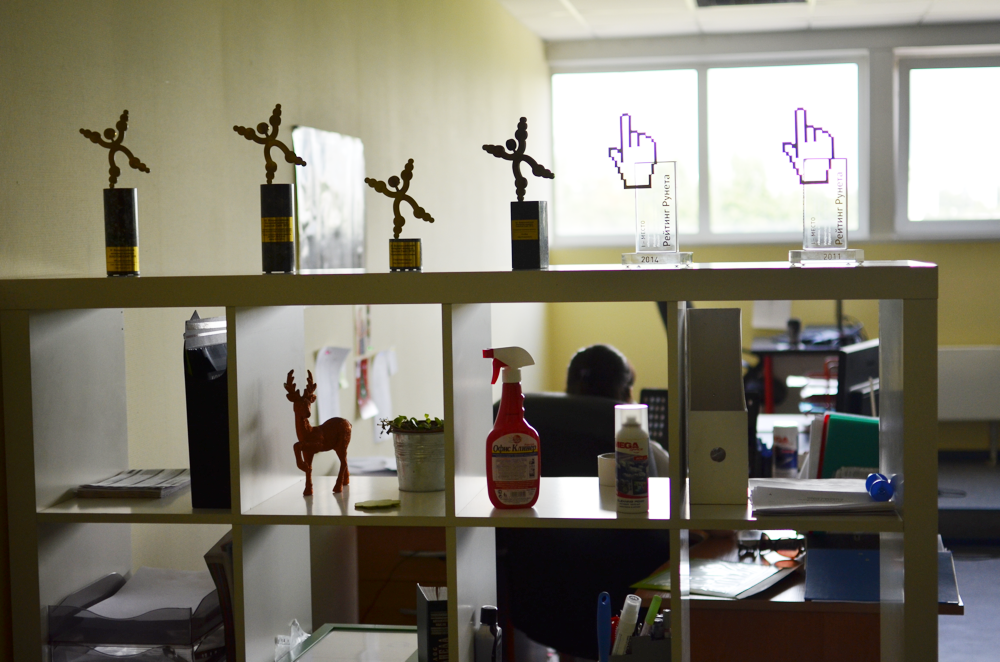
The second tool we are using now is content marketing. We have a blog, and we write articles there. Some of them are written specifically for the media. Articles work better than speeches, so we no longer speak at conferences. But it is quite possible that we have not learned to use this tool. Another thing is backstage business lunches that gather marketing directors of leading companies. They bring tangible benefits, they can not only find customers, but also partners.
We are working with retargeting in Google. And Facebook also leads several leads a week. We promote individual posts: cases or news, and the page as a whole.
- I noticed that a lot of your articles are published in business publications.
- Yes, a year ago we decided that we would stop in this direction. By publishing articles on the blog and on CMSmagazine, we realized that we need to go further. Not once heard that the business audience reads such publications. The effect is very good. To the point that we come to a meeting with a client, and he says that he just read our article in the business section of The Village. And decent traffic comes from these editions. In sales and tenders helps tab that we are published in federal publications.
- Egor, tell us about your positioning. Is Greensight more agency or production?
- Today we are a manufacturing and consulting agency. We specialize, on the one hand, in the ability to pack any product or service so that they are understandable to the consumer, and on the other hand, in the ability to solve technological problems of any complexity. And we are well versed in marketing and analytics, with the help of them we confirm the development and design, which are always a hypothesis.
Now we are working on a new positioning. So it turns out that every summer we review our view of our goals and objectives in order to get away from the paradigm of another web studio or agency. This year is no exception. “We take business online” - something like this will be our future slogan. Such positioning did not arise from scratch. This was facilitated by the trend towards the emergence of projects with the development of a business model, business plan and strategy for business development on the Internet.
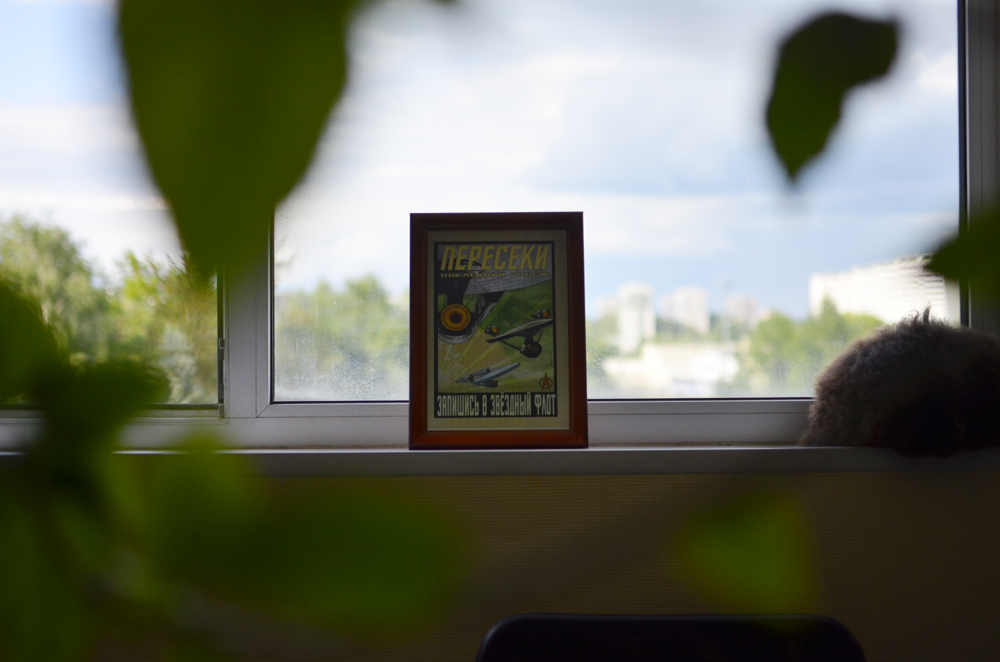
- Will you cut production?
- No way. We even canceled the practice of working with developers to outsource. There are teams with which it is pleasant to work, for example, “Bright”, but there are also some very unscrupulous studios (I will not name them, the market knows them). Therefore, we decided to further develop our own production. First and foremost, qualitatively, since we will need competences and expertise in working with complex industrial IT systems. While we have integrated with them, but not implemented. There will be a mix of integrator and consulting agency.

- Everyone understands that the company can not be everything perfect. What problems are you solving now?
- We have a certain way in which we identify our problems. We draw a tree that grows from small branches-problems to the fundamental ones. Recently, we have identified a few thin places.
The first is defocusing. Despite the fact that we are positioning as an e-commerce agency and have already accumulated a lot of projects in this area, we have a lot of work that is completely unrelated to electronic commerce. These are projects from the past without positioning, which we could not refuse earlier. As a result, such a diversity in terms of strategy is bad for the development of the company. We create stories that are not interesting to us, diverting resources. Now we face the task of learning to cut off the excess.
The second is saving on employees. This does not mean that we hire students, but we always try to find a specialist as experienced as possible, but cheaper. For example, we do not have a single person who would have a salary of more than 100 thousand rubles. There is a suspicion that this is the wrong strategy. Perhaps we would be more efficient at times with fewer staff, but more expensive.
The third is the imperfection of the processes. This is a huge layer of work, here you can get away with your head and never get out. We finish them all the time.
The fourth subtle place is internal training and corporate culture. After the introduction of the new incentive system, people began to relax less in the office. Now we have the most frequent word - profitability. “Enough to sit here, you underestimate my profitability,” such conversations began.
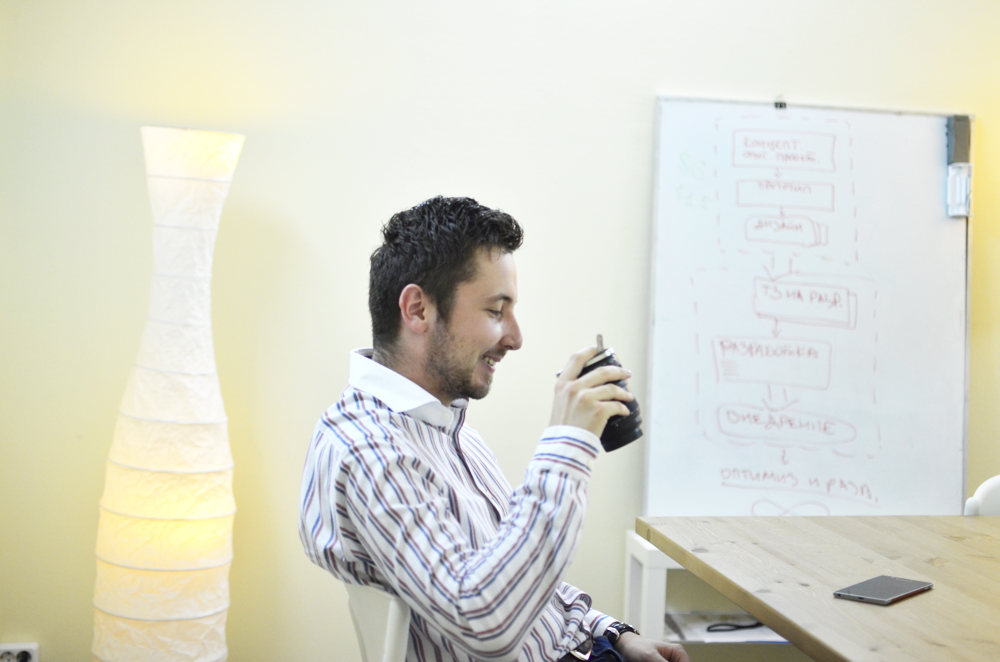
We have an internal TED: “Those are still speakers,” where each employee can speak on any topic in half an hour. Boring Tuesday is a weekly internal newsletter. We conduct corporate events and brainstorming. But still, we see that some employees, especially remote ones, know little about the company and are not attached to it emotionally. We need to introduce new formats, develop another activity.
What do you think about the business of web studios? Do you have a system for measuring the key financial indicators of your business? What are your ways to motivate staff? Which of the listed promotion channels do you think are successful? Tell your success story. I am pleased to hear your comments. And together with Egor Volkov I will answer any questions.
 I am Maria Azizova, editor of the blog of business ideas Simtech Development
I am Maria Azizova, editor of the blog of business ideas Simtech Development
My current source is Egor Volkov, CEO and co-owner of the Greensight agency.

')
Greensight is known in the market for one of the brightest starts, or the bulk effect, as they call it. Having opened a week before the crisis, in a couple of years the agency turned out to be in high positions in all key ratings. In his portfolio, only first-class work and famous brands. Greensight was conceived as a subsidiary of QSOFT, and became its competitor. And they also live and work in Zelenograd and see only advantages in this.
In the management of the agency owners use a systematic approach. This means that all their business processes are controlled and strictly regulated. And Greensight is an open company and generously shares its experience and knowledge. Here you will find tips that you can implement in your business tomorrow.
If you are the head of a small and medium business, and even more so the owner of a web studio, you are experiencing a growth crisis, you do not understand how to make your employees work efficiently, you want to manage systematically, but you don’t know where to start, I strongly advise you to read this interview. Yegor and I prepared it especially for you.
Company Overview:
Positioning: Production Agency with a focus on functional and e-commerce projects
Brands: Gazprom, Mail.Ru, Zurich, Sportmaster, PIK, TsentrObuv, ZyXEL, Jamilco, IBS, Alexey Navalny, Investkafe, Gamepark, Trends Brands, Sogaz, B & N Bank, New Balance, Timberland, etc.
Offices: Zelenograd
Staff: 50 employees
Ratings: 24th place (“Runet Rating”), 7th place (developer rating of online stores in the premium segment “Runet Rating”), 19th place (Ruward), 14th place (“Tagline”)
Agency history: start in crisis
- Egor, tell me, please, how did it come about that Greensight was launched as a regional production-office of QSOFT, and in fact became an independent agency?
- At that time I was in QSOFT the head of the unit (internal structural unit QSOFT). When the idea of opening a regional office arose, I suggested Zelenograd. Despite the fact that it is administratively related to Moscow, the location outside the Moscow Ring Road gave the main competitive advantage - the cost of specialists. And the presence of a large technical university solved the personnel issue.
As one of the initiators, I was assigned an organization. The new division decided to issue as a separate legal entity. I prepared a business plan, found two partners, my comrades, and hired one programmer. QSOFT handed us its current client - a major federal bank for the contract. And we set about. It was September 1st. Together with the students, we sat at the desks in our new office, which was too large for four people. And this week there was a global economic crisis. At the same time, it became clear that our client’s money would be enough only for office rent and salary.

QSOFT allowed to post on our website those projects in which I personally participated. As many think, there were no financial investments. In addition, at the beginning it was assumed that QSOFT would give us a part of their projects for succession, but very soon in the conditions of the crisis the number of orders decreased, they needed to provide their team with work. We were in free swimming. It was necessary to urgently look for new customers.
I must say that sales went fast. Already in the first month I signed two contracts for three projects - two online stores and one corporate site. Then we started working with Rolf, our key client of those years. But there was not enough money, we had very hard cash gaps. Customers did not pay. Depression. There was a time, we with partners already wanted to scatter. We met with the problems of shortage of orders and the growth of accounts receivable from the first days of our company. And hardened, probably.

By the way, the company was still not ours, we were only hired employees. In order to motivate and support us in a crisis, the guys from QSOFT gave us a little less than half of the company to share. Two years later we grew up and bought out the rest. Now we meet on all tenders as competitors. We still have friendly relations with QSOFT. Misha (Mikhail Tokovinin - from aut.) Speaks well of us. It did not work out ( Smiles ) .

“Who else is part of Greensight’s partners besides you?”
- Pavel Sitkin, executive director, came from an integrator company. Vladimir Loskutov, our technical director, until Greensight worked in one of the oldest web studios in Zelenograd. Later we were joined by Sergey Melikhov, creative director. He was the lead designer at Deluxe Interactive, we lured him to a lower salary, but a share in the company. In Greensight, Sergei brought the design to a new level.
Navalny effect: how to wake up famous
- So, after a year or two, you had a small team, accounts receivable, a few of your own projects in the portfolio, but you grew 1.5 - 2 times a year. How was it?
- The first time, the main channel for obtaining leads were applications from the 1C-Bitrix developers rating. In addition, we launched projects, and through word of mouth, leads led to us, which were converted into orders. We drew design on all tenders for free, even when we were not asked for it. It even seems to us that we have messed up the market with our free design. (Laughs.) We really wanted sales. By the way, now I am of the opinion that this is not necessary. By experience, we won less often than precisely in those tenders where we prepared the design.
- Tell me, what is this story with Navalny?
“Since we still did a lot of free work, Serezha Melikhov had an idea to create a social project. One day he saw a blog post from Sergei Doli, saying that some studio made him a website. The audience reach was huge! We wanted to repeat this experience. We chose 20 top bloggers and wrote them about the offer to make the site for free. And received zero responses.
Two weeks later, Alexey Navalny responded. He was not yet involved in high-profile political scandals. He liked the idea, but he could not imagine what kind of site he needed. We have prepared a detailed description of the possible options for the project, just a huge amount of text. Imagine, he answered only two months later. But we were lucky. We launched and highlighted the project simultaneously with the release of a very loud investigation of multi-billion embezzlements at Transneft and received a flurry of appeals to which we were not prepared. More than 20 applications per day. Of course, half - from fans of freebies. But there were some decent offers.
Six months later, we repeated this story and made the RosYam project for Navalny. True, this project was already paid. A new round of PR has permanently secured for us the image of a company supporting social projects. Especially in the eyes of the liberal-minded intellectuals, who were many in the top management of large companies. We hit our target audience.
Business processes: a systematic approach
- How is the organizational structure of your company? What kind of specialists does it consist of?
- All directors, accounting, office management and document management are included in the administrative department. By this we, I think, are no different from others. The development department consists of the development manager, front-end, back-end developers, web designers, system administrators. There is a sales department and a project management department consisting of project managers and the head of this direction. Our design department consists of interface designers and an art director. The latter is a hired specialist, whom we were lucky to get from another agency a year ago.
Since the direction of e-commerce is key for us, we have created an e-commerce department. This includes a marketer, web analyst and director of e-commerce, who worked in-house in top online stores. He has his own KPI system, focused on presale and postsales in his own direction.
Despite the very specific organizational structure, our activity is of a project nature. For each new project we form a separate team from different departments. Each team has a lead developer. In addition, the same person can participate in several projects simultaneously. That is, in one day an employee can work in three teams, and thanks to a very clear resource planning and separation of tasks into atomic components, his work is written up to 15 minutes.

- I noticed that in this structure you do not have an HR specialist. How do you cope without it?
- Search and selection of employees involved in the direction of the leaders. They evaluate the load, take the initiative to hire for general discussion and then select the specialists they need, full-time employees or outsourcing.
- How do sales work for you?
- All sales activities in our company are strictly regulated. The bonus system, the rules for holding meetings, negotiating, when the lead has just appeared and when negotiations are at the transaction stage, the project transfer regulations are documented and available to all employees in the internal knowledge base.
We have a big team going to meetings. I am convinced that in this case, really "alone in the field is not a warrior." First, in the company you feel more confident. Secondly, each participant has his own competences, and the negotiations are more convincing. Yes, and customers like this attention from our side. Just yesterday, we were at a meeting. And although there were only four of us, the client was very surprised, so many people had never come to them. Even the right bargaining room could not immediately be found.
We use Estonian CRM Pipedrive. This system strictly monitors the progress of the transaction. For example, a transaction must be accompanied by regular activity. If not, the system signals to the head of the sales department that his reaction is required.

Next, we collect all the transaction documentation in CRM. No matter how the communication with the client, through corporate channels or personal messengers, the information should be transferred to the project summary in CRM. What is it done for? We had problems when the sales manager was negotiating with customers on Viber or WhatsApp. And he quit before the transfer of the project, without informing the project manager of his arrangements. As a result, the client has a gap of expectations.

When the client has agreed to work together, the manager should receive information about the planned date of payment. This is a mandatory item, in the absence of which the project is not transferred to the final stage. After all, if he did not give information about payment, it means that he is not yet completely ours. On the market there is a widespread belief that a client becomes ours only when he sells a second contract. And my experience suggests that this is true.
If the client has disappeared or changed his mind, the information is also summarized. Then after a month or two a second touch occurs.
If the tender is lost, we record the reason, participants and winners in CRM. Immediately this information may not be disclosed, but later we will definitely find out about it.
The transfer of the project into production is one of the most subtle places in our work. So that the project manager does not read the entire history of communication with the client, the resume should contain detailed information about the transaction, squeeze what the sales manager agreed with the client. In addition to TK and documentation, there should be a description of the client, his psychological features, and arrangements for the future.
The transfer of the project takes place necessarily live with the sales team, the project manager and key people of the future project team. The explanation "on the fingers" means a lot.
- When did you come to the conclusion that you need CRM?
- Initially, I was one of the sales. I had a system of folders with files of requests from mail. Sometimes I forgot to save them, and turned the mail upside down in search of correspondence history. But when you're alone, you can do something on your knee. With the emergence of the sales department had to think about the competent interaction with the client.

We tried a huge number of systems, usually it did not go beyond the trial period. I can mention a few. "Megaplan" we used to manage projects and in parallel tested CRM. We did not like it. For two years I worked at Highrise 37signals. I don’t know how they are doing now, but a couple of years ago it was a terrible system, more like a notebook. We tried AmoCRM from QSOFT. It is good for most studios fit. But it is much simpler than Pipedrive, on which we ultimately settled down, and were very pleased. Attentive Russian-speaking support service, pleasant price and the richest functionality.
We try to automate processes. Mail, calendar, office applications such as Word, Excel and Powerpoint - all of this closes the infrastructure of corporate applications from Google. In business administration (hiring and firing employees, accruals, logging meetings for project groups, as well as news and events of the company, tasks outside the project processes, business processes for administration and management of the company, working groups for the development of areas, staff directory, structure companies, knowledge base and wiki regulations, etc.) - Bitrix Corporate Portal. In project management - Redmine. We are planning the loading of directions based on the LeanKit system.
- Yes, I almost forgot about project management. Are you still as strict as in sales?
- In project management, we even use two systems. The first is a resource planning system, a LeanKit electronic board, it is necessary for detailed planning of project executors loading, as well as an advance reservation of resources for up to 4 months. Every week there is a rescheduling at the so-called management summits. Project managers together with directors discuss issues related to projects, processes, conflicts in resource management.

In agencies, there is a problem of lack of resources. I think it is contrived. When we introduced budgeting, it immediately became clear that freeing up resources was not so difficult. What usually happens? The sales department signals that a big project is being developed. And here the panic begins. “We need a developer and three designers at once in reserve, we won’t be able to do it,” the managers are worried. Now we all count and prioritize. We eliminate non-core, non-profitable and uninteresting projects.
Further, all the work on the project is carried out in Redmine: communication with the client and setting goals. Metrics on resource costs and cost immediately imported to our internal dashboard in Google Docs.
Our project managers and accounts are the same employees. This was done so that the manager was interested not only in completing the current project, but also in re-selling.

Financial management and motivation: do you need to disclose profits to employees?
- You often mention in the press the so-called dashboard, which helps keep abreast of and manage the financial performance of the company. Tell me more about it.
- This is called finance dashboard. We came to this during the next development crisis in 2013. For a long time it seemed to us that everything was going well with us. But when we started counting, it turned out that intuition in business does not work, and the large revolutions of a large project are confusing. For example, when calculating the profit from a seemingly expensive project, it could turn out that it brings us losses of minus 200 thousand rubles a month. At some point we realized that we could not further develop if we did not start counting.
Our dashboard is a system of specially designed tables, it aggregates numbers across all business processes of a company. Only we (partners) see part of the data, and managers in our areas of responsibility see some.
Key indicators that we believe:
- revenue for the year, for each month;
- profitability of the year, each month;
- rates of profitability of each month and the average for the year;
- debit, credit and balance of the year;
- Top 10 clients in terms of revenue and profitability;
- sales and after sales funnels;
- interest on total revenue on the fact and on the total accounts receivable.
There are also data on the effectiveness of employees, for example, the top 10 managers in revenue, receivables and postsales. And many more different numbers.
By all indicators, we make a forecast, now we already have a calculation for 2016. Everything is considered automatically using Google Docs tables.
- You are not confused in such a number of numbers?
- Everyone does not need absolutely all the numbers. For this, we have divided the tables. Each manager has only the data he needs, which are exported from other tables. For example, a development manager knows about the profitability of his direction now, in the past and in the future. He sees the structure of all payments, including employee taxes. His task is to make his direction as profitable as possible, and we see only the final results.
In addition, our dashboard was introduced evolutionarily. At first we kept cash flows, then began to aggregate the data into reports, then we brought them together into a single system and began to show employees.
- Do you disclose company earnings data to employees?
- Ordinary employees do not see the pace of the company. Until. This is available only to managers. But the circle of persons is gradually expanding. We are in favor of increasing transparency with increasing our income. We have a certain level, reaching which we will be able to reveal our numbers not only to employees, but also to the market.
I believe that the Russian web development market will change as soon as the first public company appears. Then the rapid growth will begin. I think that this will happen soon enough. And we would be interested in becoming such a company. We have been working for several years already in white, we transfer wages to a card along with bonus payments and do not understand why it has become customary to argue with the crisis that business cannot survive without salaries in envelopes.
- It turns out that the disclosure of speed - is part of your motivational system?
- No, this is not motivation, but stimulation. We share these two concepts. The employee must be motivated to work initially. Material history from the field of incentives, but money cannot be a motivator. Motivation is a topic about interest, charge for work. Otherwise, you can get into a situation where you have a lot of disloyal employees motivated by the loot. In our opinion, this is wrong.


Our premium system is an incentive. And the important point is the efficiency of the project teams. According to the results of the work of production teams on projects (stages, or months of work, when it comes to SLA), the metrics from Redmine are fixed and automatically go to Google-tables, where everything is calculated and entered first in the project reporting, and then in the financial one. This allows managers to judge the performance of project teams, individual performers. In case of profitability of the project, bonuses are awarded to the project team. Premiums for SLA-projects are awarded monthly.
Within the team, the prize is distributed according to the scheme:
- not less than 20% - to the project manager;
- not less than 20% - to the leading designer;
- not less than 20% - to the leading developer;
- not less than 10% - to the resource manager of the production unit in case of non-use of outsourcing;
- 30% - between the other employees who worked on the project.
If someone fails, the whole team does not receive a bonus. Therefore, inefficient people are rejected by the team itself.

We tied the employee's stimulation to the profitability of the project implemented by him, but at the same time it was necessary to link it with the profitability of the entire business. It is not enough to deduct from the cost of the project to employees. The profitability is affected by the effectiveness of other projects, not to mention the cost of back-office, accounting, marketing.
We have been looking for the ideal formula for profitability rates for a long time and, finally, brought it ourselves.
Project Profit = Project Revenue - (Project Man-hours * Studio Costs / Studio Man-hours).
With this formula, we were able to get rid of situations when an employee received a bonus on one project, while throwing others, and the company was at a loss (a very detailed story about material stimulation in Greensight here is from the author).
Participation in tenders: a game without rules
- Do you have personal recipes for winning tenders?
- They simply can not be! Tenders are an unpredictable process. Sergey Prokofiev from CreativePeople told me how they once refused to participate in the tender, and after a while they received a message that they won it. It happens.
Another situation from my practice. The client sent a proposal to participate in the tender in the top 30 studios, but put everyone in an open copy. Correspondence between the participants broke out, everyone forgot about the project and only laughed at the inept actions of the client. I decided to answer him on the merits. Wrote by removing everyone from the copy. And we won the tender. The company was from Chelyabinsk, a leading manufacturer of equipment for educational laboratories in Russia and the CIS countries. The project budget was also very good. After we talked, it turned out that the client knew that it was impossible to do this, the open copy was accidental. But he immediately became clear who is worth something.

If a request is created unprofessionally, this does not mean at all that it should be filtered.
Tenders are very different. In cases when you are speaking before the board of directors of a transnational holding, your closest competitor is preparing for the door, and another one is speaking before you, the advice will not help. It comes with experience.
Definitely need a sales system and strict adherence to it. First, high-quality marketing materials: business cards, presentations, portfolio. Secondly, a clear positioning of the company, when you can immediately respond, than you are better. Thirdly, knowledge of their cases, their pros and cons, the ability to tell about themselves with interest.
If we talk about the processes, then, with other exceptions, the meeting sells best. Therefore, any more or less interesting lead needs to be converted into a meeting, and already there to hone your skills. At meetings, you can sell something that the client did not know, which he did not even think about.
And of course, the preparation for the tender plays a crucial role. We have up to seven people participating in it. The presentation for presale is a whole project work.
Company promotion: content marketing in action
- On which whales, except for word of mouth, is your promotion built today?
- Big traffic bring ratings. Positions in ratings and banners. The topic of ratings is interesting. Everyone knows that they provide sales, but to get into any of them, you need a lot of quality work that can not be obtained without participating in the rating. A vicious circle of some kind. If you are not yet in the general list or you are standing somewhere at the very end, where customers do not have enough patience to penetrate, buy banners on the Tagline, Runet Rating, RUWARD. At first, these tools work the same way, because the client remembers you as a company from the rating.

The second tool we are using now is content marketing. We have a blog, and we write articles there. Some of them are written specifically for the media. Articles work better than speeches, so we no longer speak at conferences. But it is quite possible that we have not learned to use this tool. Another thing is backstage business lunches that gather marketing directors of leading companies. They bring tangible benefits, they can not only find customers, but also partners.
We are working with retargeting in Google. And Facebook also leads several leads a week. We promote individual posts: cases or news, and the page as a whole.
- I noticed that a lot of your articles are published in business publications.
- Yes, a year ago we decided that we would stop in this direction. By publishing articles on the blog and on CMSmagazine, we realized that we need to go further. Not once heard that the business audience reads such publications. The effect is very good. To the point that we come to a meeting with a client, and he says that he just read our article in the business section of The Village. And decent traffic comes from these editions. In sales and tenders helps tab that we are published in federal publications.
- Egor, tell us about your positioning. Is Greensight more agency or production?
- Today we are a manufacturing and consulting agency. We specialize, on the one hand, in the ability to pack any product or service so that they are understandable to the consumer, and on the other hand, in the ability to solve technological problems of any complexity. And we are well versed in marketing and analytics, with the help of them we confirm the development and design, which are always a hypothesis.
Now we are working on a new positioning. So it turns out that every summer we review our view of our goals and objectives in order to get away from the paradigm of another web studio or agency. This year is no exception. “We take business online” - something like this will be our future slogan. Such positioning did not arise from scratch. This was facilitated by the trend towards the emergence of projects with the development of a business model, business plan and strategy for business development on the Internet.

- Will you cut production?
- No way. We even canceled the practice of working with developers to outsource. There are teams with which it is pleasant to work, for example, “Bright”, but there are also some very unscrupulous studios (I will not name them, the market knows them). Therefore, we decided to further develop our own production. First and foremost, qualitatively, since we will need competences and expertise in working with complex industrial IT systems. While we have integrated with them, but not implemented. There will be a mix of integrator and consulting agency.

- Everyone understands that the company can not be everything perfect. What problems are you solving now?
- We have a certain way in which we identify our problems. We draw a tree that grows from small branches-problems to the fundamental ones. Recently, we have identified a few thin places.
The first is defocusing. Despite the fact that we are positioning as an e-commerce agency and have already accumulated a lot of projects in this area, we have a lot of work that is completely unrelated to electronic commerce. These are projects from the past without positioning, which we could not refuse earlier. As a result, such a diversity in terms of strategy is bad for the development of the company. We create stories that are not interesting to us, diverting resources. Now we face the task of learning to cut off the excess.
The second is saving on employees. This does not mean that we hire students, but we always try to find a specialist as experienced as possible, but cheaper. For example, we do not have a single person who would have a salary of more than 100 thousand rubles. There is a suspicion that this is the wrong strategy. Perhaps we would be more efficient at times with fewer staff, but more expensive.
The third is the imperfection of the processes. This is a huge layer of work, here you can get away with your head and never get out. We finish them all the time.
The fourth subtle place is internal training and corporate culture. After the introduction of the new incentive system, people began to relax less in the office. Now we have the most frequent word - profitability. “Enough to sit here, you underestimate my profitability,” such conversations began.

We have an internal TED: “Those are still speakers,” where each employee can speak on any topic in half an hour. Boring Tuesday is a weekly internal newsletter. We conduct corporate events and brainstorming. But still, we see that some employees, especially remote ones, know little about the company and are not attached to it emotionally. We need to introduce new formats, develop another activity.
What do you think about the business of web studios? Do you have a system for measuring the key financial indicators of your business? What are your ways to motivate staff? Which of the listed promotion channels do you think are successful? Tell your success story. I am pleased to hear your comments. And together with Egor Volkov I will answer any questions.
 I am Maria Azizova, editor of the blog of business ideas Simtech Development
I am Maria Azizova, editor of the blog of business ideas Simtech DevelopmentSource: https://habr.com/ru/post/292138/
All Articles